#egyptian painting
Text

Amy Nimr (Egyptian, Cairo 1898 [1907]–1974 Paris)
Untitled (Anatomical Corpse)
1940
#Amy Nimr#surrealist#surrealism#surrealist art#surrealist artist#surrealist painter#surrealist painting#egyptian artist#Egyptian painter#Egyptian painting#art on tumblr#aesthetic#beauty#modern art#art history#tumblr art#tumblrpic#tumblrpictures#tumblraesthetic#aesthetictumblr
9 notes
·
View notes
Text
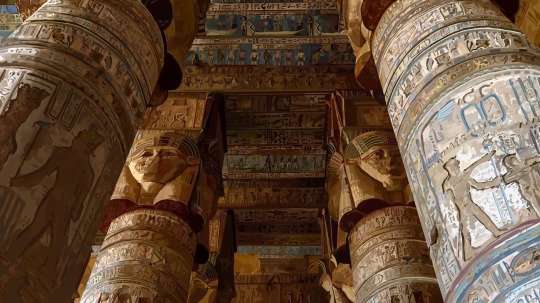
I know this isn't ninjago guys but I finished this 17 hour painting for my art class and I was proud of it so...enjoy.
I love Egypt fun fact about me. :)
[ID: a detailed, realistic painting of the hathor columns at the dendera temple complex in dendera, egypt. /end ID]
#my art#art#egypt#egyptian#egyptology#egyptian art#ancient egypt#antiquity#ancient art#ancient egyptian#painting#digital painting
140K notes
·
View notes
Text

0 notes
Text
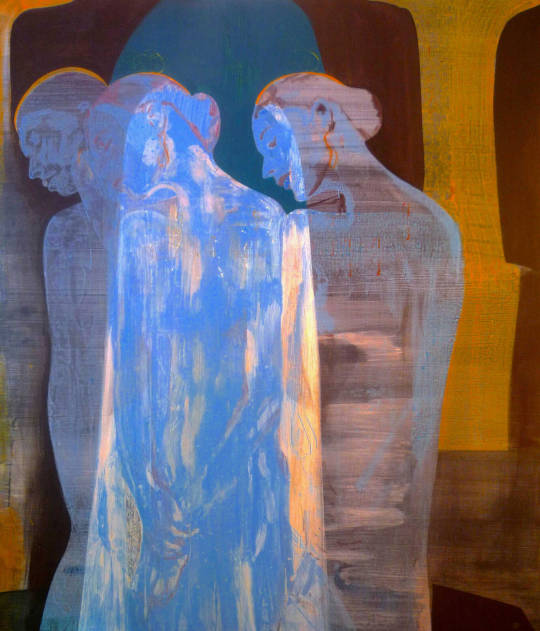
Essam Marouf (Egyptian, 1958) - Untitled (2010)
4K notes
·
View notes
Photo

Sah by Maksim Kneht
1K notes
·
View notes
Text

Mummy portrait (wax encaustic on sycamore wood) of a girl, from the Fayum region of Egypt. Artist unknown; ca. 120-150 CE (reign of Hadrian or Antoninus Pius). Now in the Liebieghaus, Frankfurt am Main, Germany. Photo credit: Carole Raddato.
#history#ancient history#Ancient Egypt#Roman Empire#Roman Egypt#art#art history#ancient art#Roman art#Egyptian art#Romano-Egyptian art#mummy portrait#encaustic painting#Liebieghaus
3K notes
·
View notes
Text

Jean-André Rixens (French, 1846-1925)
The Death of Cleopatra, 1874
#Jean-André Rixens#The Death of Cleopatra#1874#1800s#art#fine art#european art#classical art#europe#european#fine arts#oil painting#europa#egyptian#egypt#cleopatra#cleo#Jean Andre Rixens
998 notes
·
View notes
Text

His name has been Set. And Seth. And Sithifer. And his one true name forevermore is...
SUTEKH
#art#my art#digital art#digital illustration#fanart#artists on tumblr#clip studio paint#doctor who#fifteenth doctor#the doctor#dr who#15th doctor#new who#classic who#pyramids of mars#sutekh the destroyer#fourth doctor#tardis#egyptian mythology#sutekh#sutekh doctor who#doctor who spoilers#the legend of ruby sunday#susan triad#mrs flood#empire of death#dw theory
593 notes
·
View notes
Text

~ Pottery bowl containing paint, once belonging to a fresco painter.
Period: Roman
Date: A.D. 1st century
Place oforigin: Egypt
#ancient#ancient art#history#museum#archeology#roman#ancient history#archaeology#ancient Egypt#egyptology#Egyptian#Egypt#paint#pottery#pottery bowl#1st century
12K notes
·
View notes
Text
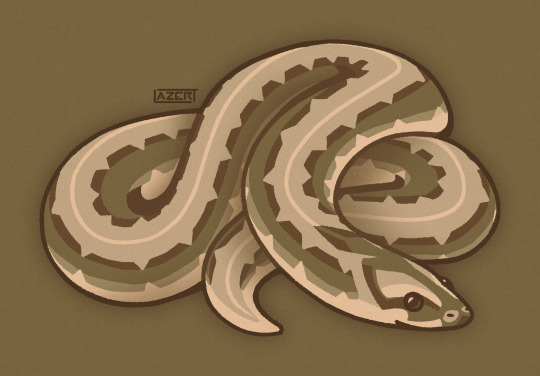
Sand Boa illustration commission for @lyndzparker
#not open for 2d commissions right now#this was something arranged months ago#art#my art#digital#digital art#illustration#clip studio#clip studio paint#csp#snake#boa#sand boa#kenyan sand boa#anery stripe sand boa#egyptian sand boa#Eryx colubrinus#commission#commissioned work#lazert#lazer-t#stylized
420 notes
·
View notes
Text

Abdel Hadi El-Gazzar
The Green Man
1951
Oil on Canvas
Private Collection
194 notes
·
View notes
Text

Georges Jules Victor Clairin (1843-1919) - La Deesse Neith (The Goddess Neith), 1900
#georges jules victor clairin#la deesse neith#the goddess neith#prime creator#egyptian mythology#esoteric art#occult art#fantasy art#classical art#art#oil painting#painting
198 notes
·
View notes
Text
The speed painterrrrrrr
#cotl#cult of the lamb#aychama#cotl lamb#cotl narinder#art#speed paint#Timelapse#Egyptian mythology au
245 notes
·
View notes
Text
2,000-Year-Old Fayum Portraits from Roman Egypt: also known as "mummy portraits," these funerary paintings were often fastened to the coffins of the people they depicted
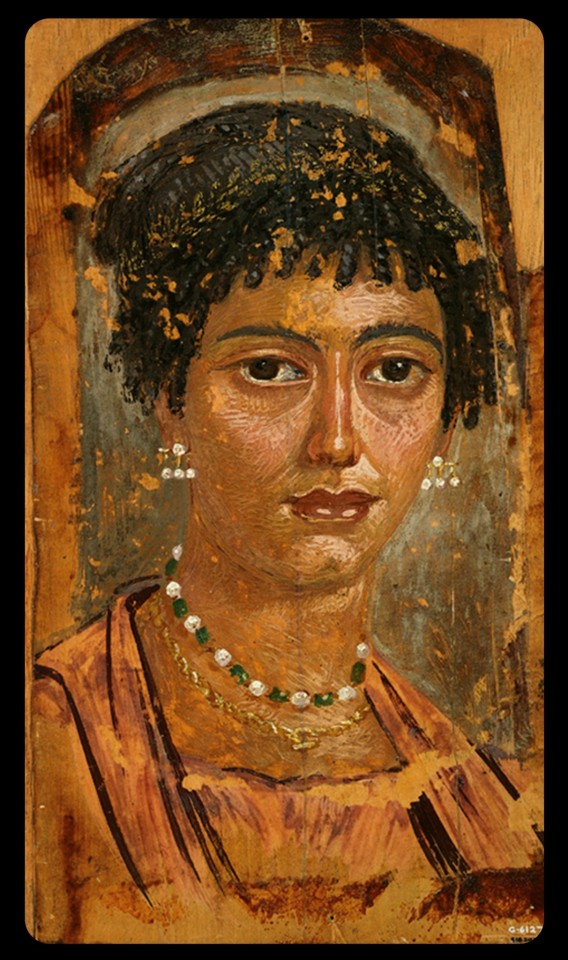
Above: Fayum portrait of a woman from Roman-occupied Egypt, c.100-110 CE
Fayum portraiture was a popular funerary practice among the upper-class families of Roman Egypt from about 50 CE to 250 CE. Given the high mortality rates for children during this period, many of these portraits depict children and youths, but adults were often featured, too.
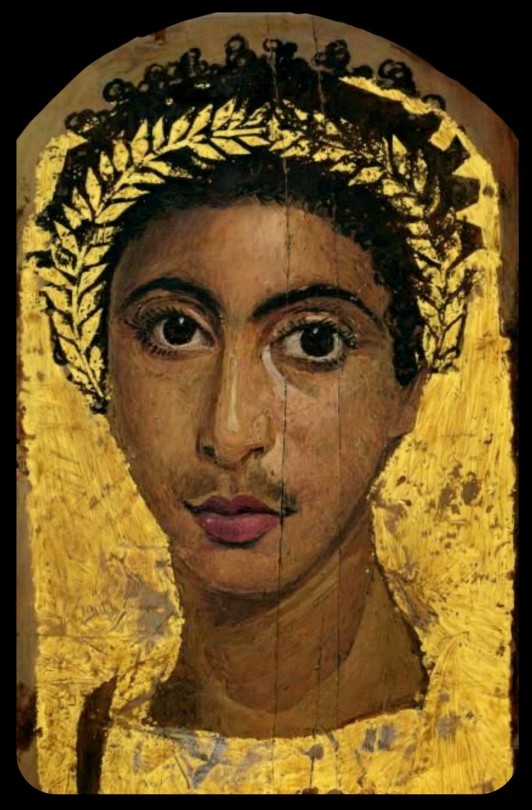
Above: portrait of a youth wearing a golden wreath, c.130-150 CE; the wreath and the background of the portrait are both gilded
The population of the Faiyum Delta, where most of these portraits were found, largely contained individuals with both native Egyptian/North African and Greek heritage. The Greek lineages can be traced back to the Ptolemaic period, when the Greeks gained control of Egypt and began to establish settlements throughout the region, gradually leading to a cultural diffusion between the Greek and Egyptian populations. The Romans eventually took control of Egypt in 31 CE, absorbing it into the Roman Empire and colonizing much of North Africa, but the demographics of the Faiyum Delta remained largely unchanged.

Above: portrait of a man with a mole on his nose, c.130-150 CE
Many of these Fayum portraits reflect the same blend of ethnic and cultural roots, depicting individuals with both Greek and native Egyptian heritage (a claim that is supported by both archaeological and genetic evidence). Some portraits may also depict native Egyptians who did not have any European ancestry, but had been integrated into Greco-Roman society.

Above: portrait of a bearded man, c.170-180 CE
These representations of native Egyptians provide us with unique insights into the actual demographics of Roman-occupied Egypt (and the ancient world at large). Non-European peoples are rarely included in depictions of the classical world; it's also interesting to see the blend of cultural elements that these portraits represent.

Above: portrait of a priest of Serapis, c.140-160 CE; the man in this portrait is shown wearing a fillet/crown that bears the seven-pointed star of the Greco-Egyptian god, Serapis
As this article explains:
In the 1800s and early 1900s, Western art historians didn’t know what to make of these portraits. Scholars of Roman history labeled them Egyptian. Scholars of Egyptian history labeled them Greco-Roman. These binary academic classifications failed to capture the true complexity of the ancient (or, indeed, modern) Mediterranean. In reality, Fayum portraits are a syncretic form, merging Egyptian and Greco-Roman art and funerary practices. They reflect the cosmopolitanism of both Roman and Egyptian history.
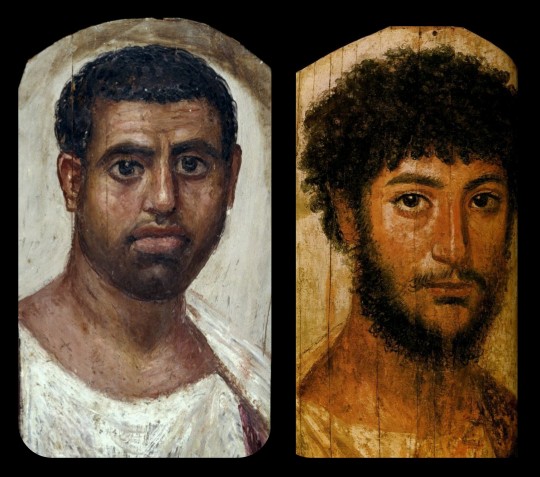
Above: portrait of a man, c.80-100 CE (left); portrait of a bearded officer, sometimes referred to as "Perseus," c.130-175 CE (right)
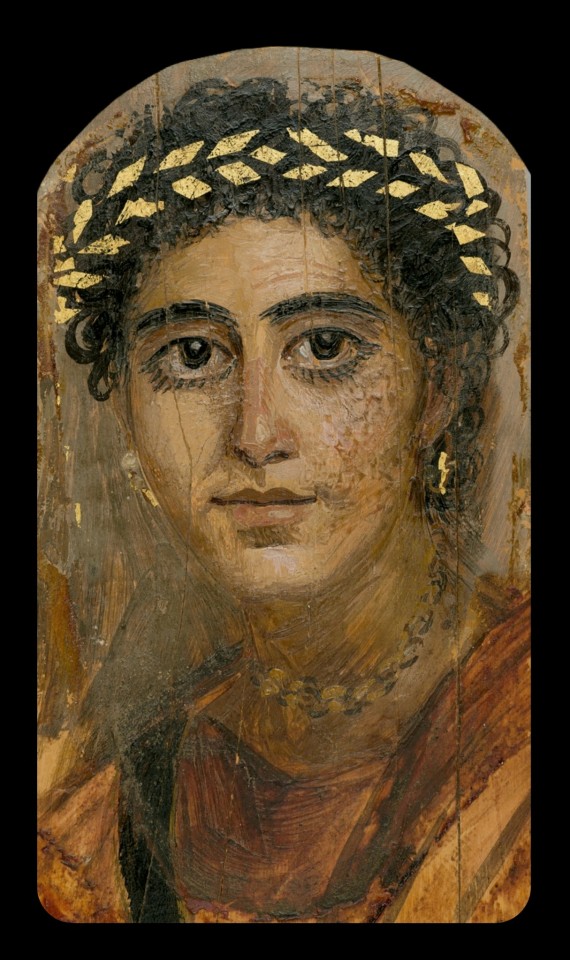
Above: portrait of a young woman in red, c.90-120 CE
Nearly 1,000 of these portraits are currently known to exist.
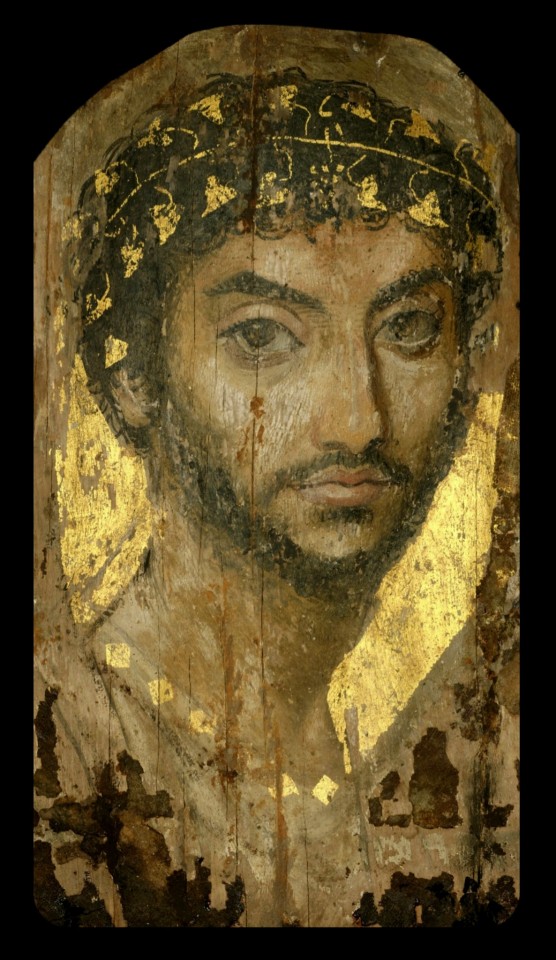
Above: portrait of a man wearing a gilded ivy wreath, c.100-150 CE
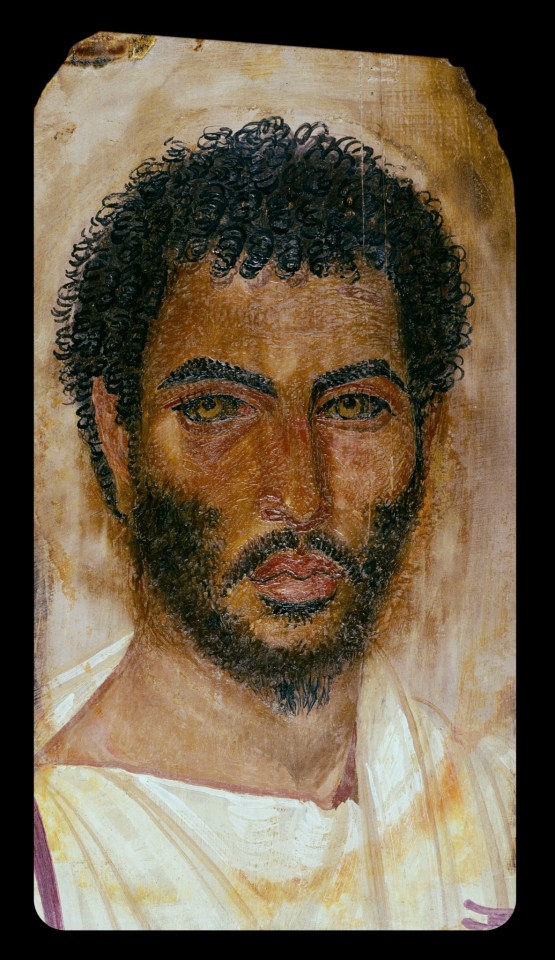
Above: portrait of a bearded man, c.150-170 CE
Sources & More Info:
Curationist: Fayum Portraits
Harvard Art Museums: Giving the Dead their Due: an Exhibition Re-Examines Funerary Portraits from Roman Egypt
Getty Museum: APPEAR Project
Getty Museum: Faces of Roman Egypt
National Geographic: Ancient Egypt's Stunning, Lifelike Mummy Portraits
The Athens Centre: The Myth of Whiteness in Classical Sculpture
Forbes: Whitewashing Ancient Statues: Whiteness, Racism and Color in the Ancient World
#archaeology#artifact#anthropology#history#ancient history#art#fayum portraits#roman egypt#ancient rome#ethnography#painting#portrait#north africa#people of color#egypt#religion#greco roman#greek#classical antiquity#fayum#mummy portraits#romano egyptian#representation
222 notes
·
View notes
Text

Essam Marouf (Egyptian, 1958) - Untitled (2009)
236 notes
·
View notes
Text
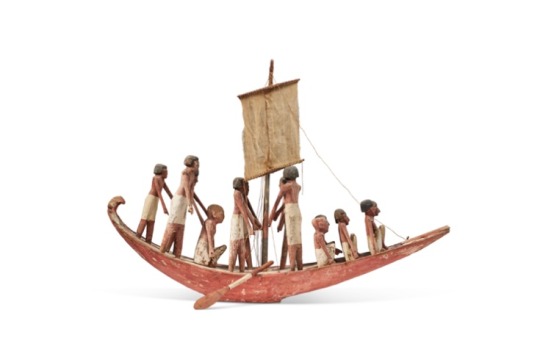

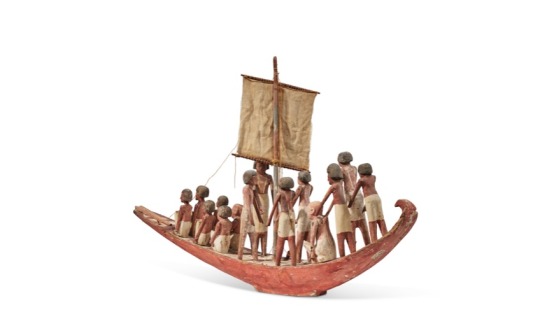
AN EGYPTIAN GESSO-PAINTED WOOD FUNERARY MODEL OF A BOAT
MIDDLE KINGDOM, 11TH-12TH DYNASTY, 2087-1759 B.C.
#AN EGYPTIAN GESSO-PAINTED WOOD FUNERARY MODEL OF A BOAT#MIDDLE KINGDOM#11TH-12TH DYNASTY#2087-1759 B.C.#ancient artifacts#archeology#archeolgst#history#history news#ancient history#ancient culture#ancient civilizations#ancient egypt#egyptian history#egyptian mythology#egyptian art
419 notes
·
View notes